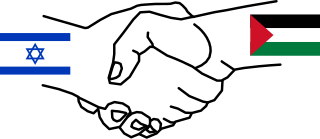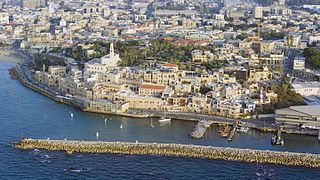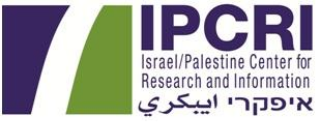
Yitzhak Rabin was an Israeli politician, statesman and general. He was the fifth prime minister of Israel, serving two terms in office, 1974–1977, and from 1992 until his assassination in 1995.

Shimon Peres was an Israeli politician who served as the eighth prime minister of Israel from 1984 to 1986 and from 1995 to 1996 and as the ninth president of Israel from 2007 to 2014. He was a member of twelve cabinets and represented five political parties in a political career spanning 70 years. Peres was elected to the Knesset in November 1959 and except for a three-month-long interregnum in early 2006, served as a member of the Knesset continuously until he was elected president in 2007. Serving in the Knesset for 48 years, Peres is the longest serving member in the Knesset's history. At the time of his retirement from politics in 2014, he was the world's oldest head of state and was considered the last link to Israel's founding generation.

The Oslo I Accord or Oslo I, officially called the Declaration of Principles on Interim Self-Government Arrangements or short Declaration of Principles (DOP), was an attempt in 1993 to set up a framework that would lead to the resolution of the ongoing Israeli–Palestinian conflict. It was the first face-to-face agreement between the government of Israel and the Palestine Liberation Organization (PLO).

The Palestinian territories are the two regions of the former British Mandate for Palestine that have been occupied by Israel since the Six-Day War of 1967, namely the West Bank and the Gaza Strip. The International Court of Justice (ICJ) has referred to the West Bank, including East Jerusalem, as "the Occupied Palestinian Territory", and this term was used as the legal definition by the ICJ in its advisory opinion of July 2004. The term occupied Palestinian territory was used by the United Nations and other international organizations between October 1999 and December 2012 to refer to areas controlled by the Palestinian National Authority, but from 2012, when Palestine was admitted as one of its non-member observer states, the United Nations started using exclusively the name State of Palestine. The European Union (EU) also uses the term "occupied Palestinian territory". The government of Israel and its supporters use the label "disputed territories" instead.

Arab–Israeli peace projects are projects to promote peace and understanding between the Arab League and Israel in different spheres. These are part of a broader attempt at a peace process between Palestinians and Israelis. Sponsors of such projects can be found both in Israel and Palestine.
The so-called Elon Peace Plan is a plan to resolve the Israeli–Palestinian conflict through the principles of rehabilitation of Palestinian refugees, Israeli sovereignty over the occupied Palestinian territories, and strategic cooperation with Jordan, based on Jordan becoming a Palestinian state.

The Arab citizens of Israel are the country's largest ethnic minority. They are colloquially referred to in Arabic as either 48-Arabs or 48-Palestinians, denoting the fact that they have remained in Israeli territory since the Green Line was agreed upon between Israel and the Arab countries as part of the 1949 Armistice Agreements. According to several sources, the majority of Arabs in Israel now prefer to be identified as Palestinian citizens of Israel. International media outlets often use the term "Arab-Israeli" or "Israeli-Arab" to distinguish Israel's Arab citizens from the Palestinian Arabs residing in the Israeli-occupied territories. They are formerly, or are descended from, those Arabs who belonged to the British Mandate for Palestine through Palestinian Citizenship Order 1925. Speakers of both Arabic and Hebrew, they self-identify in a wide range of intersectional civic, national, and religious identities.
International aid has been provided to Palestinians since at least the 1948 Arab–Israeli War. The Palestinians view the aid as keeping the Israeli–Palestinian peace process going, while Israelis and other foreign policy authorities have raised concerns that it is used to fund terrorism and removes the imperative for Palestinians to negotiate a settlement of the Israeli–Palestinian conflict. As a provision of the Oslo Accords, international aid was to be provided to the Palestinians to ensure economic solvency for the Palestinian National Authority (PA). In 2004, it was reported that the PA, within the West Bank and Gaza Strip, receives one of the highest levels of aid in the world. In 2006, economic sanctions and other measures were taken by several countries against the PA, including suspension of international aid following Hamas' victory at the Palestinian Legislative Council election. Aid to the PA resumed in 2008 following the Annapolis Conference, where Hamas was not invited. Aid has been provided to the Palestinian Authority, Palestinian non-governmental organizations (PNGOs) as well as Palestinian political factions by various foreign governments, international organizations, international non-governmental organizations (INGOs), and charities, besides other sources.

The Arava Institute for Environmental Studies is an academic studies and research institute located in Kibbutz Ketura on the Israeli side of the Arava Valley. Following the understanding that "nature knows no borders", the Arava Institute's mission is to advance cross-border environmental cooperation in the face of political conflict.

The Arab Peace Initiative, also known as the Saudi Initiative, is a 10 sentence proposal for an end to the Arab–Israeli conflict that was endorsed by the Arab League in 2002 at the Beirut Summit and re-endorsed at the 2007 and at the 2017 Arab League summits. The initiative offers normalisation of relations by the Arab world with Israel, in return for a full withdrawal by Israel from the occupied territories, with the possibility of comparable and mutual agreed minor swaps of the land between Israel and Palestine, a "just settlement" of the Palestinian refugee problem based on UN Resolution 194, and the establishment of a Palestinian state with East Jerusalem as its capital. A Palestinian attack called the Passover massacre took place on 27 March 2002, the day before the Initiative was published, which initially overshadowed it.

The Moshe Dayan Center for Middle Eastern and African Studies is an Israeli think tank based in Tel Aviv, Israel, focused on the contemporary study and analysis of the Middle East and Africa. Its stated primary mission is to serve as a resource for decision makers and the public at large, both in Israel and internationally, though it differentiates itself from other similar organizations by refraining from recommending specific policies outright.
The following events occurred in the year 2007 in Israel.

The Center for Jewish-Arab Economic Development (CJAED), located in Herzliya Pituach, Israel, is a non-profit, non-governmental organization founded in 1988 by Ms. Sarah Kreimer and a coalition of Jewish and Arab businesspeople. CJAED works to promote Jewish-Arab economic cooperation as well as develop a thriving Arab sector in order to establish peace, prosperity and economic stability in Israel and the region. The center's main premise is that Israel's primary resource is its people, therefore a vibrant and stable economy requires an integrated society. In 2010, CJAED was recognized as one of the "Ten Top Israeli Business Ventures" that promote peace in the Middle East.

Jaffa, also called Japho or Joppa in English, is an ancient Levantine port city founded by the Canaanites that is now part of southern Tel Aviv, Israel. Sitting atop a naturally elevated outcrop on the Mediterranean coastline, it was a strategic location that exchanged hands repeatedly in ancient Near East history, and was also contested during the Crusades, when it presided over the County of Jaffa and Ascalon.

The Israel/Palestine Center for Research and Information is a joint Israeli/Palestinian NGO and public policy think tank based in Jerusalem working towards building partnerships in Israel/Palestine. Under shared Israeli-Palestinian leadership, IPCRI carries out research and projects in various fields from economic development to environmental sustainability. IPCRI also facilitates public outreach and track two negotiations between Israelis and Palestinians.
Scandar Copti is a Palestinian filmmaker, film writer, actor and producer who examines social problems of Arab society in Israel through his film works.
The Valley of Peace initiative is an effort to promote economic cooperation between Israel, Jordan, and Palestine based around efforts and joint projects in the Arava/Arabah Valley, along which runs the southern portion of the Israel - Jordan border. It received the personal attention and support of Shimon Peres, President of Israel. The initiative involved ongoing joint efforts by regional leaders to launch joint new industrial and economic projects, which will create new local businesses and job growth, and promote ongoing cooperation.

Ajami is a predominantly Arab neighborhood in Tel Aviv-Yafo, Israel, situated south of Old Jaffa and north of the Jabaliyya neighborhood on the Mediterranean Sea.

Israel–Palestine relations refers to the political, security, economical and other relations between the State of Israel and the State of Palestine. Israel and the PLO began to engage in the late 1980s and early 1990s in what became the Israeli–Palestinian peace process, culminated with the Oslo Accords in 1993. Shortly after, the Palestinian National Authority was established and during the next 6 years formed a network of economic and security connections with Israel, being referred to as a fully autonomous region with self-administration. In the year 2000, the relations severely deteriorated with the eruption of the Al-Aqsa Intifada – a rapid escalation of the Israeli–Palestinian conflict. The events calmed down in 2005, with reconciliation and cease fire. The situation became more complicated with the split of the Palestinian Authority in 2007, the violent split of Fatah and Hamas factions, and Hamas' takeover of the Gaza Strip. The Hamas takeover resulted in a complete rift between Israel and the Palestinian faction in the Gaza Strip, cancelling all relations except limited humanitarian supply.

Israeli–Palestinian economic peace efforts refers to efforts to promote joint economic projects between Israelis and Palestinians, as a pathway to reach peace between the two groups.
















